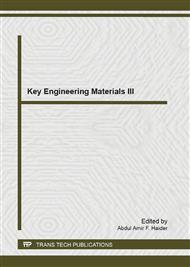p.28
p.32
p.37
p.42
p.47
p.53
p.59
p.64
p.71
Dielectric Properties of the Composite Insulator Mica Epoxy-Novolac
Abstract:
As electric insulators of the copper conductors in the electric generators of alternative current or in electric motors of high tension, there are used with priority the composite crosslinked mica-epoxy. Pre-impregnated band with solvent was introduced, the impregnation being performed with phenolic-novolac resin. The studied material got superior dielectric properties at function temperatures corresponding to the insulation class F(155C). Its main components are: mica paper (53%), glass cloth (13%) and the basic epoxy phenolic-novolac resin. The complex permittivity and conductivity were determined with the Time Domain Spectrometer (TDS); the apparatus allows the determination of the electric values in the domain of frequencies: very large domain of frequencies. The temperature varied in the domain 23-190C with the help of an oven. The purpose of this article is to report the dielectric properties of mica-epoxy-novolac composite insulator, for which very few data have so far been published.
Info:
Periodical:
Pages:
47-52
Citation:
Online since:
May 2013
Authors:
Price:
Сopyright:
© 2013 Trans Tech Publications Ltd. All Rights Reserved
Share:
Citation:


